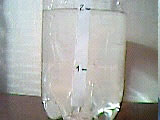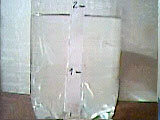


|
The volume problem
Science at Home |
||
|
Materials
|
Compounds
|
Pictures: 

|
|
Procedure
1. Cut a paper strip and glue it in the bottle. 2. With a measure flask, measure 200 ml of water. (you can measure another amount, but later you should use always that volume) 3. Pour the measured water in the bottle. 4. Mark the level of water in the paper strip with a (1). 5. Add more 200 ml of water to the bottle. 6. Mark the second level of water with a (2). 7. Empty the bottle and let it dry. 8. Pour again 200 ml of water to the bottle. 9. Now, measure 200 ml of ethyl alcohol in the measure flask. 10. Pour the 200 ml of alcohol to the bottle. (mix well the two liquids) 11. You can verify that the level of the final mixture is lower than the level (2) that was marked previously. It is proven that 200 ml of water more 200 ml of alcohol aren't 400 ml. Why?(1+1 is different from 2) |
||
|
Why?
How is it possible that 200 ml of water more 200 ml of ethyl alcohol aren't 400 ml? Do you think that is has happened a reaction? The answer is: you missed! The interactions between the water molecules are hydrogen bridges type. These interactions form empty "holes" between molecules due to the fact that they are established between one oxygen and two hydrogen atoms. Between the ethyl alcohol molecules it will also exist hydrogen bridges interaction, but with smaller intensity compared to water. When water is added to alcohol, it will form a non ideal mixture because the final volume doesn't correspond to the total added. That is due to the possible interaction between the water and alcohol molecules, because they have similar intermolecular interactions. The empty spaces between water molecules will be "filled" by alcohol molecules, reducing the total final volume. Try it at home! |
||
No part of this website can be reproduced without previous authorization. Please inform me if there is any problem with the website. |